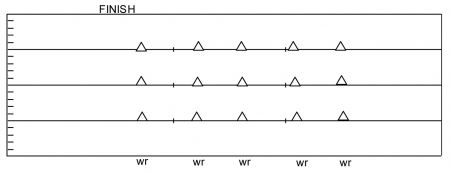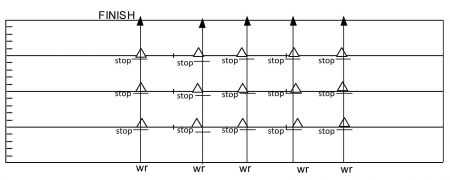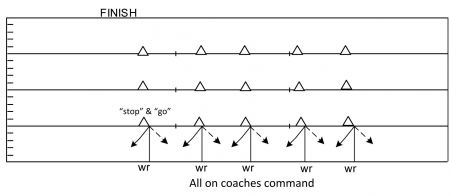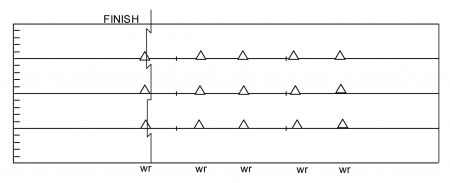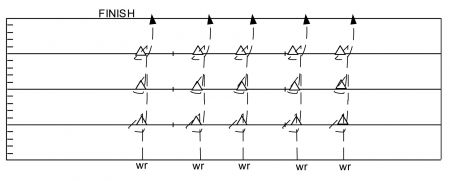Article CategoriesAFM Magazine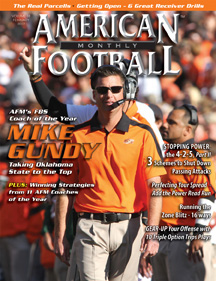
|
Drills Report – Getting Open: Drills to Make Your Wide Receivers Greatby: Brian CristFormer Wide Receivers Coach, University of Massachusetts © More from this issue The most important part of any passing game is the ability of wide receivers to get open. Your type of passing system will determine what types of routes are run, but the ultimate success of the passing game will be based on your wide receivers abilities to get open at the right time for the quarterback. Over the years, I have coached some outstanding receivers, and all the great ones had the ability to get open. The key is practice repetition. We work on a grid square every day to help us develop the muscle memory and fundamentals to help wide receivers that can get open. To become a great wide receiver, you have to be able to stop and start before the defensive back. Knowing and understanding how to do this is a critical part of route running. Many factors contribute to being able to “stop on a dime”. Mostly, it is a matter of controlling your body by using simple techniques. In these drills, we will break down into small parts what happens at the point of a route when you need to stop. The laws of motion say, “A body in motion tends to stay in motion”. That is why we want to try to slow down using our lower body and not our head and shoulders. In each drill, we have a series of cones placed in front of the receivers. The cones will be at 5-yard intervals. We will work on each phase of the break in small detail (See Diagram 1 for grid square set-up).
Diagram 1. GRID SQUARE – 5-yard distance, 3-5 yards width The first thing we do every spring and every fall is put receivers in the correct “stopped position”. That is, with their head over their toes, knees bent, and arms in running position. Essentially this is the same stance as their starting stance, except they are lower. At first it will be a little uncomfortable, but that’s what we want. This is where muscle memory takes over. We’ll do this a couple of times and then, using the grid, we will have them walk in this position without ever rising up. This is the starting point every season. From there we will progress to the drills below (Diagram 2).
Diagram 2. Walk in ‘stopped stance’ - coach’s command The first drill is to run straight out to the cone in as few steps as possible. We try to make it in three steps. Ask the receiver to stop by taking his nose to his toes, as if a sting runs from the end of his nose to his big toe. By slamming his foot into the ground, it should pull that string which pulls his head and shoulders down. We want to always talk about stopping in this manner. When the receiver stops, have him place his hand on top of the cone in the proper stopped position with knees bent, shoulders over toes, and arms in a running manner. The receiver should stay in this position until the coach commands him to “go” to the next cone, and the next group goes. This continues all the way through to the finish line (Diagram 3).
Diagram 3. Stop on cone – receiver and coach’s pace
Diagram 4. Stop and go – coach’s command The next phase is to have the receiver make a break at his own pace. However, we don’t make the whole break right away. We want the receiver to get used to the feel of stopping, but not actually come to a complete stop. As I mentioned earlier, it is about breaking the fundamentals down into small details. Here we will run to the cone, semi- stop, and make a quarter-turn back to the start. He then continues onto the next cone where we will repeat the quarter-turn in the other direction. We still want them to drop their weight slightly, turn their shoulders back, and keep their shoulders at the same level as they turn up field. There should be no rise and fall of the shoulder level (Diagram 5).
Diagram 5. Quarter-turn drill To finish, we put the whole thing together by stopping, coming back to the ball and exploding up field. Using the same cone grid, the receiver will explode off the ball and go slightly past the first cone. The receiver will stop in the correct manner and turn back to the quarterback as he did in the previous drill. We do not want to make a big circle as the receiver comes back. Also, we want to keep our feet under our shoulders and not be over- extended. Being over-extended will make us slower out of our breaks and on our escape up the field. The receiver will go to the next cone and repeat the same mechanics. Unlike the other drills where he went on the coach’s command, the receiver does this drill at his own pace. We want it fast, but under control (Diagram 6).
Diagram 6. Curl drill – receiver’s pace All of these drills are done in both directions. They are designed to get a wide receiver’s muscles to know how it feels to be in the correct position when they are stopping and starting. The faster and more efficient they are at controlling their body, the better they will be able to create space away from the defender. The space created will be the difference between a completion and an interception. These drills can be done at your pace as a coach or the players pace. This set of drills only deals with making a break back towards the line of scrimmage. We use the cone grid for all of our other breaks as well (speed cut, post cut, corner cut, etc.). I hope these drills can be useful in developing your wide receivers. Over the last five years we have had nine all-conferences receivers, and I feel our daily emphasis on getting open is a major factor in that accomplishment. |
|
| HOME |
MAGAZINE |
SUBSCRIBE | ONLINE COLUMNISTS | COACHING VIDEOS |
Copyright 2024, AmericanFootballMonthly.com
All Rights Reserved


